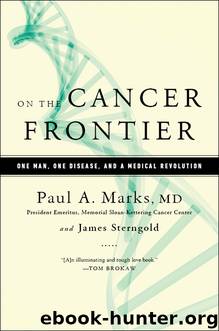On the Cancer Frontier by Paul Marks

Author:Paul Marks [Marks, Paul A.; Sterngold, James]
Language: eng
Format: epub
ISBN: 9781610392532
Publisher: PublicAffairs
*Charles W. Young et al., “Phase I Trial and Clinical Pharmacological Evaluation of Hexamethylene Bisacetamide Administration by Ten-Day Continuous Intravenous Infusion at Twenty-Eight-Day Intervals,” Cancer Research 48, no. 24 (pt. 1) (1988): 7304–7309.
*M. Andreeff et al., “Hexamethylene Bisacetamide in Myelodysplastic Syndrome and Acute Myelogenous Leukemia: A Phase II Clinical Trial with a Differentiation-Inducing Agent,” Blood 80, no. 10 (1992): 2604–2609.
eleven
CHANGING CANCER CARE FROM WITHIN
PROMISING AS OUR DRUG RESEARCH was, I had to work at the same time on institutional changes to improve outcomes. The complete answer, I knew, was not going to come in the form of a pill. The old treatment models were not working fast enough, and new scientific insights, while promising, simply were not being translated as rapidly as hoped into better therapies. We had to enlist more resources, and different types of resources, to really make significant improvements in how the patients did and how the patients felt. As I had found at Columbia-Presbyterian Hospital, clinical cancer care operated in a somewhat insular world. I decided to take a calculated gamble and replace Ted Beattie, the physician in chief overseeing Memorial Hospital. Though a superb cancer surgeon, he had allowed the hospital’s clinical approach to become overly dependent on surgery as the principal method for dealing with the broad range of cancers. I felt we needed a clinical leader who could expand our programs in medical oncology and radiotherapy—that is, to provide excellence in all the areas of cancer care.
Surgery is very important and can be highly effective in cases where a tumor can be removed before it has metastasized or, at the least, before it has metastasized widely. Good candidates for surgical cures represented, however, only about a third of the patients who came to Memorial in the early 1980s.
The problem was that the emphasis on “heavy cutting” had pushed other treatments, such as chemotherapy, radiation therapy, or immunotherapy, into the background. In Beattie’s view, you turned to drugs or radiation only if the doctors had been unable to control or remove the cancer with surgery. I believe he saw the use of chemotherapy drugs, immunological approaches, and radiotherapy as signs of failure, not supplementary measures to help patients live longer.
I appreciated the importance of surgery, of course, but, because I had already been working on a pioneering targeted therapy drug, I believed strongly that it was time to bring more tools to bear on what was still a relatively poor record in improving the lives of cancer patients. There had been some advances in developing chemotherapy “cocktails,” that is, treatments with mixtures of drugs designed to hit different targets in cancer cells.
This combination therapy was producing prolonged remissions in about 80 percent of children with acute lymphoblastic leukemia, for example, but nothing as dramatic in adults. Researchers had developed the first clinically useful biomarker test for a cancer, in this case a means of detecting prostate cancer (with the prostate-specific antigen, or PSA, test), often well before the patient developed symptoms. Still, we were not doing well enough clinically on those patients with proven cancers.
Download
This site does not store any files on its server. We only index and link to content provided by other sites. Please contact the content providers to delete copyright contents if any and email us, we'll remove relevant links or contents immediately.
Periodization Training for Sports by Tudor Bompa(8217)
Why We Sleep: Unlocking the Power of Sleep and Dreams by Matthew Walker(6659)
Paper Towns by Green John(5142)
The Immortal Life of Henrietta Lacks by Rebecca Skloot(4552)
The Sports Rules Book by Human Kinetics(4348)
Dynamic Alignment Through Imagery by Eric Franklin(4179)
ACSM's Complete Guide to Fitness & Health by ACSM(4023)
Kaplan MCAT Organic Chemistry Review: Created for MCAT 2015 (Kaplan Test Prep) by Kaplan(3972)
Introduction to Kinesiology by Shirl J. Hoffman(3744)
Livewired by David Eagleman(3730)
The Death of the Heart by Elizabeth Bowen(3582)
The River of Consciousness by Oliver Sacks(3574)
Alchemy and Alchemists by C. J. S. Thompson(3484)
Bad Pharma by Ben Goldacre(3399)
Descartes' Error by Antonio Damasio(3250)
The Emperor of All Maladies: A Biography of Cancer by Siddhartha Mukherjee(3114)
The Gene: An Intimate History by Siddhartha Mukherjee(3076)
The Fate of Rome: Climate, Disease, and the End of an Empire (The Princeton History of the Ancient World) by Kyle Harper(3035)
Kaplan MCAT Behavioral Sciences Review: Created for MCAT 2015 (Kaplan Test Prep) by Kaplan(2960)
